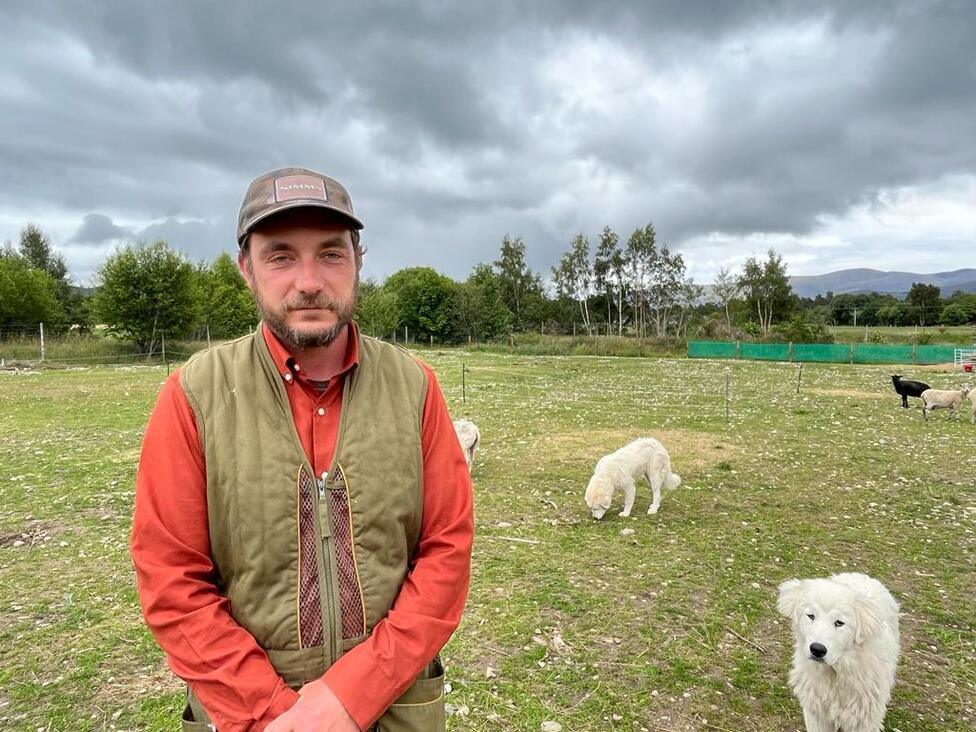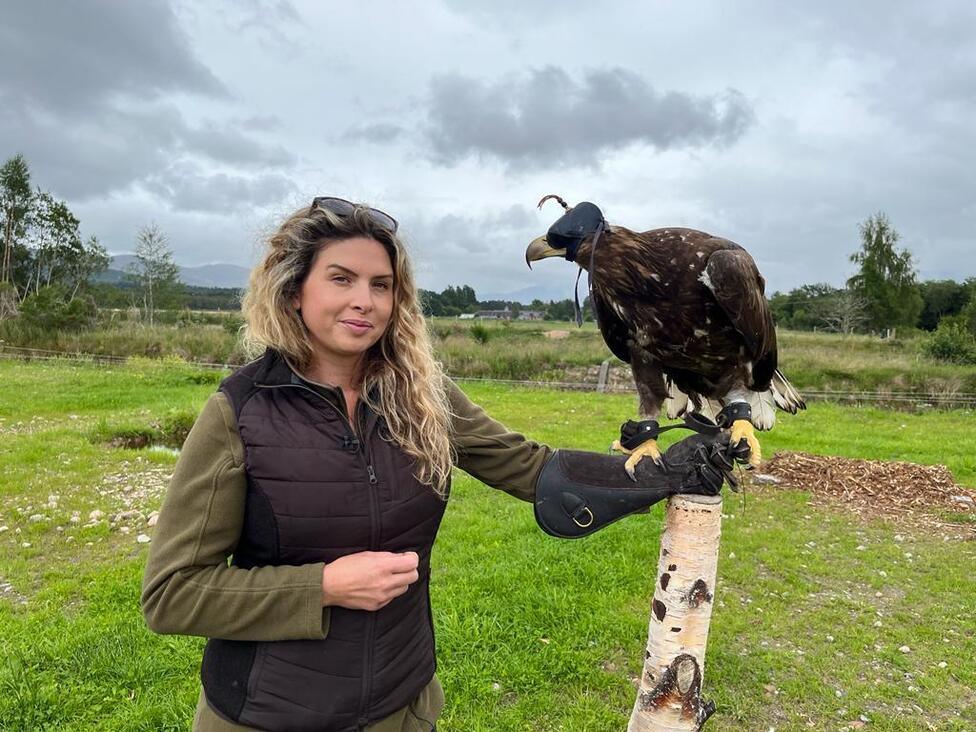Maremma sheep dogs trained to protect Highland herd from sea eagles
- Published

The Maremma sheep dogs' white coat means farmers can easily distinguish them from predators such as wolves
Specially-trained guardian dogs from the Alps could be used to help protect new born lambs from sea eagles.
Highland falconers are training two Maremma sheep dogs to look out for the large birds of prey in the sky.
The breed - which have white coats and are easily distinguishable from animals like wolves - typically live with herds driving away predators.
Farmers believe white-tailed sea eagles have killed hundreds of lambs over the last decade.
It is Scotland's largest bird of prey and was reintroduced on the west coast almost 50 years ago.
For years, Italian shepherds have used Maremma sheep dogs to scare off wolves - but falconers hope to train the dogs to look out for predators from above.
Jonathan and Daisy Ames from Rothiemurchus Falconry near Aviemore are training two young Maremma sheep dogs, called Luigi and Peaches, to protect newborn lambs.
"This particular breed dates all the way back to the Romans," said Mr Ames. "They've been around for thousands of years."
During the training - which currently happens for a short time each day - the falconers encourage the dogs to chase a drone with an eagle lure attached.
They want the dogs' protective instinct to kick in when they see a predator threatening a sheep.
The aim is for the dogs to live with and protect the herd full-time.

Jonathan Ames with the young Maremma sheep dogs
"It gives them aerial awareness training - and it's a bit of fun as well," said Mr Ames added.
"We have a white-tailed eagle here at the centre and whilst in a controlled environment, we will let the dogs see her eat what they think is a sheep carcass.
"So before they do go and try it for real, they should've seen a predator eating what they think is their sheep."
Sea eagles can have an 8ft (2.4m) long wingspan and are sometimes known as flying barn doors.
The powerful birds of prey can pick up geese and lambs depending on the weather.

Falconer Daisy Ames with a white-tailed sea eagle
"A lot of work has gone into bringing sea eagles back here and it does a lot of good for tourism and the ecosystem," said Mrs Ames.
"They're really bold birds, and they'll learn very quickly that lambs are an easy prey item to take for their chicks.
"But they will also quickly learn that there are predators with those lambs that run and bark at them.
"If the sea eagles get injured they can't hunt and feed their chicks, so they know that the lambs are no longer easy prey."
The dogs will patrol lambing paddocks, instead of trying to protect entire herds.
Mr Ames explained: "From what we understand about eagle behaviour, they don't like heavy confrontation.
"If they perceive these barking dogs as a top predator, they don't want to want to go in and risk being injured."
Once the dogs are trained, they will join a larger flock in December so the sheep have a couple of months to get to know the dogs before they lamb.
John Willie Gilles, the chair of the North Raasay Sheep stock club, has been a crofter since he left school.

John Willie Gilles said the eagles are the biggest problems facing his lambs
Over the last decade crofters in the Highlands say that hundreds of their lambs have been taken by sea eagles.
"It's been an issue since they were introduced," said Mr Gilles.
"We noticed a significant impact on our lambing percentages in 2012, anywhere where the birds were nesting. Our lambing percentages dropped 30% from one year to the next.
"There's no other reason that it would happen - I've seen enough bad weather and any other problems you can have.
"But they are the biggest problem we could have.
"It shows what happens every year: If they're not rearing chicks, they're not killing as many lambs.
"But if they are rearing chicks, then you're finding lambs with a hole in the ribcage and the soft tissue taken away.
"The heart, lungs and liver are taken away to feed the chicks."
He added: "I don't know what the solution is, but something's got to be done."
Mr Ames hopes that if the project is successful, it could secure funding to help other farmers.
A NatureScot spokesperson said: "The Sea Eagle Management Scheme provides a range of support to holdings affected by sea eagle predation of livestock.
"This includes support for new ideas proposed by farmers and crofters participating in the scheme, in our collaborative work to mitigate sea eagle predation.
"The use of guardian dogs to mitigate sea eagle predation in Scotland is a new approach and if there is interest from farmers and crofters in exploring this approach this is something we would consider as we have with other ideas."